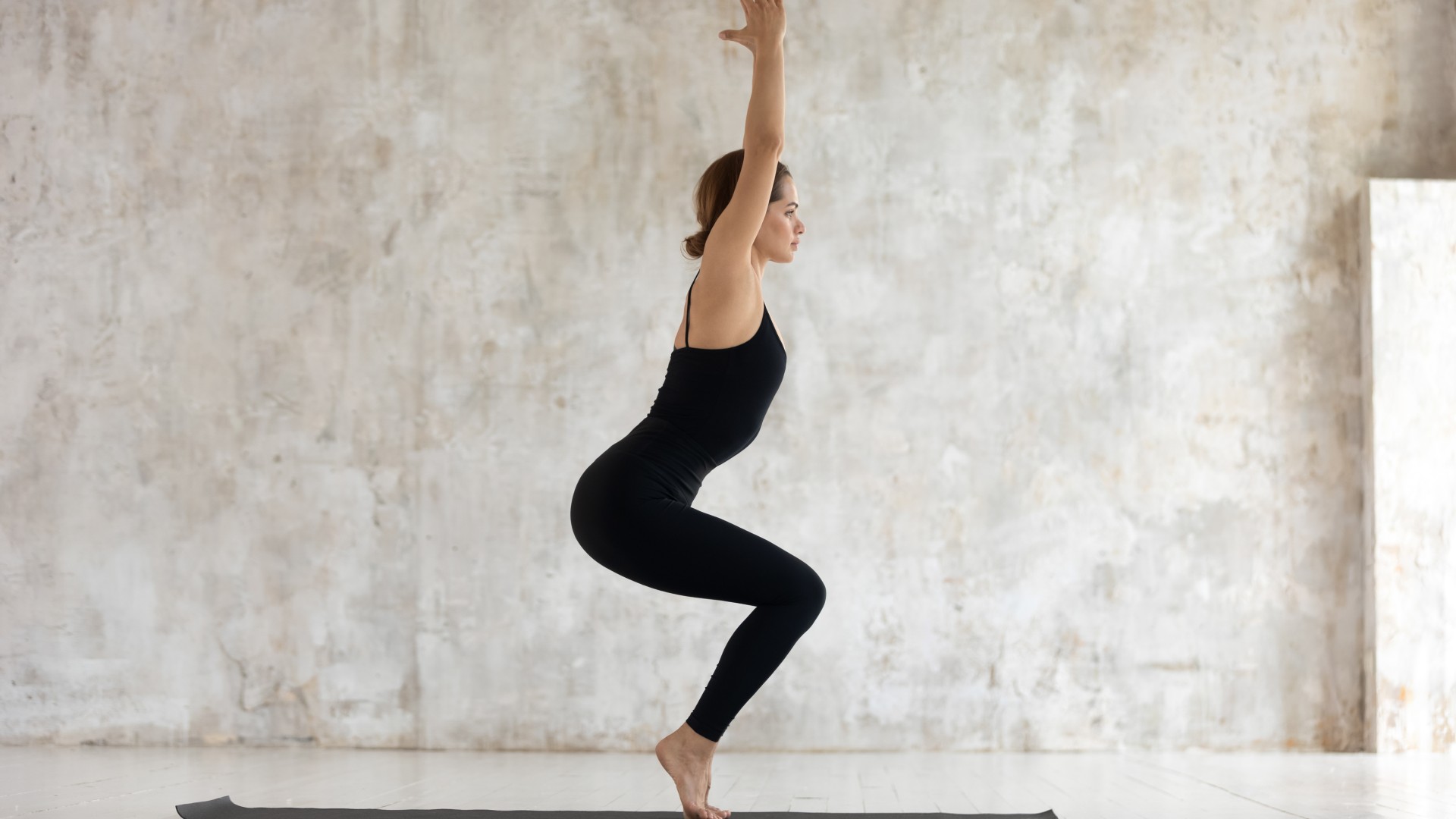This underrated bodyweight move is a secret weapon for stronger quads.If you’re looking for a fresh way to fire up your legs — or think bodyweight exercises can’t deliver serious results — let me introduce you to the sissy squat. Despite the name, there’s nothing “sissy” about it.
It’s one of the toughest lower-body moves, challenging your balance, control and quad strength like never before.Although one exercise alone won’t tone and define your legs, this exercise can certainly contribute, requiring no equipment and barely any space. But what happens if you do 100 reps a day for a week?To find out, I added sissy squats to my morning routine — and let’s just say, I felt the burn in places I didn’t even know existed.

Read on to see what happened, and grab one of the best yoga mats to practice on.How to do 'sissy' squatsStand tall with your feet about hip-width apart, next to a squat rack, wall, or anything sturdy you can hold onto for balanceLightly hold the support with one hand if you need extra stabilityBegin to slowly lean back, keeping your body in a straight line from your knees to your head. Try not to bend at the hips — this isn’t your typical squat!As you lean, allow your knees to move forward over your toes and lift your heelsPlace yoga blocks or weight plates under your heels for added support if that feels more comfortableLower yourself with control, as far as your mobility and confidence allow.
The deeper the lean, the more you’ll feel it in your quadsPress through the balls of your feet to straighten your legs and return to the starting position.The key to mastering a sissy squat is engaging your core to stay balanced. As your knees track forward, lean back just enough to counterbalance yourself — it’s all about finding that sweet spot.
Start slow, focus on form and you’ll be surprised at how quickly you feel the burn.I did 100 'sissy' squats every morning — here’s what happenedCurious about the benefits of sissy squats, I took on the challenge of doing 100 reps everyday for a week. Here’s what I learned — and why you might want to try it too.
I learned an entire new squat technique Remember the first time you did a bodyweight squat? It was about keeping your knees behind your toes. Well, forget that. The sissy squat breaks all the rules.
By design, this leg move requires your knees to travel past your toes as you lower to the ground, lifting your heels and bringing your knees toward the floor. That’s why good form is key — this squat demands control.Trust me, if you rush it or throw yourself around, your knees or glutes will let you know.
My advice? Start slow. Try a wall supported sissy squat or use a squat rack until you get comfortable with the movement, then gradually build up your confidence and depth.The squat variation worked my lower body hardI knew sissy squats would target my glutes, quads, hamstrings and core, but I wasn’t prepared for just how much they’d work my quads — way more than regular bodyweight squats.
The feeling was different, too; a deep stretch from knees to hips has to be felt to be believed.This all comes down to time under tension. As you lean back slowly, your quads experience an intense eccentric stretch, then fire up for a powerful contraction to bring you back to standing.
At the start of the week, I barely made it past 15 reps before needing to stop and shake my legs out. I had to grip my doorframe for dear life just to stay balanced. But, as the days went on, my confidence grew.
I could do more reps by the end of the week, and even shifted to holding onto the arm of my home treadmill for support with just one hand.A post shared by Igor | mobility coach 🇪🇪 (@igor.system)A photo posted by on The challenge tested my core musclesThe sissy squat targets those deep core muscles that help support your spine, forcing you to engage them throughout the entire movement.
It also strengthens your ankles by improving the flexibility and strength of the ligaments, tendons and muscles as you balance on the balls of your feet.A strong core is essential for everyday movements, whether lifting a heavy box, running 5K, or maintaining good posture while working at your desk. By strengthening these muscles, you reduce your risk of lower back injuries and improve your overall body mechanics, helping you move more efficiently and safely.
'Sissy' squats are an excellent knee strengthener — when done rightDon’t worry — sissy squats aren’t bad for your knees, as long as you’ve got healthy, strong knees to begin with. They can help strengthen the tendons around your knee joint and improve knee stability, which is key for injury prevention.To ease in, you can place weight plates or yoga blocks under your heels, so you don’t have to lower as far at first.
As mobility, control and confidence improve, you can gradually remove the blocks.This will help your knees and the muscles, tendons and ligaments surrounding them to strengthen, building resilience. This makes sissy squats a great exercise for anyone doing high-impact sports like sprinting, tennis, or paddleball where there’s lots of impact, twisting and turning involved.
It’s okay to fall over — I did Especially when trying this move unassisted.Sissy squats will seriously test your balance and coordination. A few times, I leaned too far back or forgot to engage my quads at the bottom, leaving me stuck in place.
Occasionally, I flung my arms or rocked my shoulders to stand up, which only threw me off balance even more. This is definitely not a move to rush, which is why I’m still holding on for support while doing my 100 reps.As a side note, you should never force yourself into a range of motion that feels uncomfortable.
If you experience knee pain, it’s best to stop and check your form — ideally with a trainer. While this exercise isn’t inherently dangerous, it’s not for everyone. Your joints will move naturally where they should, just don’t push beyond your limits.
They strengthen your hips and improve postureSissy squats are a fantastic way to build strength and stability in your hips. As you descend and lean back, your hip flexors control the movement, keeping you balanced while receiving a satisfying stretch.Strengthening these muscles can help with posture, making everyday movements like walking, running and even standing for long periods feel more effortless and supported.
I did 100 'sissy' squats every morning — here’s my verdictI enjoyed this challenge. The beauty of sissy squats is that you don’t need any equipment — just your body weight.Even after years of training my legs, I can honestly say these hit my quads in a way I’ve never felt before — deep stretch, deep burn and plenty of quad shaking.
But what surprised me most was the effect on my knees; I never imagined my knees could travel over my toes without discomfort, yet by the end of the week, I felt more stable and confident.Deep stretch, deep burn and plenty of quad shaking. But what surprised me most was the effect on my kneesMy ankles and hips also became more mobile, and my core had to work much harder than it typically would.
Day by day, my technique and balance improved and I felt myself getting better.I’d recommend adding sissy squats to your leg workout — whether as a warm-up or part of your strength training. After a week, I’m still progressing, holding on for balance and using just my body weight.
In time, I’d love to do them freestanding and even hold an adjustable dumbbell to my chest. There are many ways to progress this move, and I’m just getting started.More from Tom's GuideI’m a personal trainer, and these 3 moves reduce stiff hips and boost flexibilityI'm a personal trainer — I use this 5-move mobility routine to unstick my hips and shouldersForget frog pose — these 3 mobility exercises unlock tight hips and release tension in your glutes and lower back.
Technology

I did 100 'sissy' squats every day for one week — here’s what happened to my body

What is a sissy squat, and what happens when you do 100 reps every day for one week? Our writer found out with this squat challenge.















